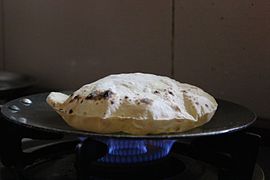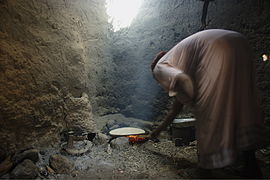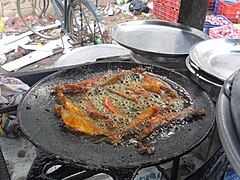Tava: Difference between revisions
imported>Citation bot (Alter: template type. Add: publisher, title, isbn. Changed bare reference to CS1/2. | Use this bot. Report bugs. | Suggested by BrownHairedGirl | Linked from User:BrownHairedGirl/Articles_with_bare_links | #UCB_webform_linked 1690/2188) |
->Arminden (Tapa is just one more local variant of tav/wa) |
||
| Line 6: | Line 6: | ||
[[File:Tava.JPG|thumb|A concave tawa designed for use in a home kitchen]] | [[File:Tava.JPG|thumb|A concave tawa designed for use in a home kitchen]] | ||
A '''tava(h)''' | A '''tava(h)''' / '''tawa(h)''' (mainly on the [[Indian subcontinent]]), '''saj''' (in Arabic), '''saç''' (in Turkish) and other variations and combinations thereof, {{clarify|reason=NOT helpful to drop all local variants into the first sentence of the grid. Local patriotism has to be left out. Only main variants here, the rest further down, or the user is overwhelmed and misses the entire point.|date=December 2021}} is a metal-made cooking utensil.<ref name=Sarkar>{{Cite web |author= Petrina Verma Sarkar |title=What Is an Indian Tawa? |website=The Spruce Eats |url=https://www.thespruceeats.com/definition-of-tava-tawa-1957547 |access-date=2019-10-02}}</ref> The tawa is round and can be flat, but more commonly has a curved profile, and while the [[concave (disambiguation)|concave]] side can be used as a [[wok]] or [[frying pan]], the convex side is used for cooking [[flatbread]]s and [[pancake]]s.<ref name=Sarkar/><ref>{{Cite book|url=https://www.google.com/books/edition/Fodor_s_Turkey/FEVEAgAAQBAJ?hl=en&gbpv=1&dq=sac+tava+wok&pg=PT751|isbn=9780804141925|title=Fodor's Turkey|date=27 May 2014|publisher=Fodor's Travel}}</ref> | ||
== | The Indian tawa might have a handle or not, and it can be made of [[cast iron]] or [[aluminum]],<ref name=Sarkar/> or of [[carbon steel]].{{cn|date=December 2021}} The utensil may be [[vitreous enamel|enameled]] or given a [[non-stick surface]].<ref>Marie Simmons, ''Things Cooks Love: Implements, Ingredients, Recipes'', 2008, {{isbn|0740769766}}, p. 251</ref><ref>{{Cite book |title= South Indian Cooking |publisher= Sanjay & Co |isbn= 9788189491796 |url= https://www.google.com/books/edition/South_Indian_Cooking/3m6DBAAAQBAJ?hl=en&gbpv=1&dq=tava+non+stick&pg=PT32 }}</ref> The tawa and saj are used in the cuisines of [[cuisine of the Indian subcontinent|South]],<ref name=Sarkar/> [[Central Asian cuisine|Central]], and [[Middle Eastern cuisine|West]] Asia, as well as of the [[Caucasian cuisine|Caucasus]] and the [[Balkans]]. The Indian tawa may even be used for [[Caribbean cuisine|Caribbean dishes]].<ref name=Island>{{Cite book |last=Mason |first=Taymer |title= Caribbean Vegan: Meat-Free, Egg-Free, Dairy-Free Authentic Island Cuisine for Every Occasion |publisher=The Experiment |year=2016 |isbn=9781615193615 |url= https://books.google.com/books?id=wuKACwAAQBAJ&q=tawa+caribbean&pg=PA14 |access-date= 2021-12-21}}</ref> | ||
In nearly all [[Indo-Aryan languages]] such as [[Punjabi language|Punjabi]], [[Modern Hindi|Hindi]] and [[Urdu]] | |||
==Names by region== | |||
===Tava, tawa=== | |||
In Iran the [[Persian language|Persian]] word '''''tāve''''' ({{lang|fa|تاوه}}{{rtl}}) is used<ref>F. Steingass, ''A Comprehensive Persian–English Dictionary'', 1930, p. 277</ref> (but see here-below for the use of ''saj'' in Iran). It is cognate with '''''tawaa''''', a words which in nearly all [[Indo-Aryan languages]] such as [[Punjabi language|Punjabi]], [[Modern Hindi|Hindi]] and [[Urdu]] means cooking pan.<ref>{{cite web|url=http://dsalsrv02.uchicago.edu/cgi-bin/philologic/getobject.pl?c.2:1:4537.platts |title=A dictionary of Urdu, classical Hindi, and English |publisher=Dsalsrv02.uchicago.edu |access-date=2017-10-11}}</ref> In Afghanistan the curved cast-iron utensil used for cooking bread is known as '''''tawah''''',<ref name=EWIC/> but in [[Pashto]] it is more popularly known as '''''tabakhey''''' (تبخے/طبخی).{{cn|date=December 2021}} The [[Georgian language|Georgian]] cognate is '''''tapa''''' (ტაფა).{{cn|date=December 2021}} | |||
===Saj, saç=== | |||
'''''Saj''''' (({{lang|ar|صاج}}, ''lit.'' sheet-metal) is the cognate of ''tava'' in Arabic,<ref>Maxime Rodinson, ''et al.'', ''Medieval Arab cookery'', 2001, p. 154</ref><ref>Hans Wehr, ''Dictionary of Modern Written Arabic'', 1966, p. 499</ref> with the equivalent '''''saç''''' or '''''sac''''' in Turkish, and is used in Southwest Asia.<ref name=EWIC>{{cite encyclopedia |editor-last= Joseph |editor-first= Suad |editor-link= Suad Joseph |editor-last2= Najmabadi |editor-first2= Afsaneh |editor-link2= Afsaneh Najmabadi |title= Encyclopedia of Women & Islamic Cultures |volume= 3: Family, Body, Sexuality And Health |page= 109 |publisher= BRILL |year= 2003 |isbn= 9004128190 |url= https://books.google.com/books?id=bzXzWgVajnQC&pg=PA109 |access-date= 21 December 2021}}</ref> In Iran ''saj'' is used for the curved iron plate employed in cooking bread<ref name=EWIC/> (but see here-above for the use of ''tāve'' in Iran). | |||
===Variants, change of meaning=== | |||
The word '''''tava''''' is also used in Turkish and all across the Balkans, and refers to any kind of frying pan.{{cn|date=December 2021}}{{dubious |reason= Introduced on 23 January 2011 by Lambiam, who proved less than rigorous on this page back then.|date= December 2021}} In Serbia and Bulgaria however, a ''тава'' (''tava'') is a metal baking tray with raised margins (for the meaning of ''sach'' in those same countries, see here-below).{{cn|date=December 2021}} In Romanian too, ''tava'' can mean [[baking tray]], such as are employed for baking in an oven, but it can also mean [[tray]], such as used for serving food and drink.<ref>[https://dexonline.ro/definitie/tavă "tavă"] at [[Dicționarul explicativ al limbii române|DEX]] online. Accessed 22 Dec 2021.</ref> | |||
The '''[[sač]]''' is a saj-shaped lid used as a cooking utensil in the Balkans. In Serbia and Bulgaria, the flat ceramic ''сач'' ('''''sach''''') or ''сачѐ'' ('''''sachè''''') is used for table-top cooking of thin slices of vegetables and meat{{cn|reason=The Bulgarian meaning comes from a native speaker, see talk-page, so fully trustworthy, but a source would help. Also, Serbian is quite a different language, I hope he got it right-especially since we also have sač for , which isn't used for "table-top" cooking.|date=December 2021}} (for the meaning of ''tava'' in those same countries, see here-above). | |||
<gallery mode="packed"> | <gallery mode="packed"> | ||
File:Pita.jpg|[[Pita]] being baked on a convex saj | File:Pita.jpg|[[Pita]] being baked on a convex saj | ||
Food_Gechresh_Azerbaijan_01.jpg|Reversible [[Azerbaijani cuisine|Azerbaijani]] | Food_Gechresh_Azerbaijan_01.jpg|Reversible [[Azerbaijani cuisine|Azerbaijani]] sac with handles | ||
</gallery> | </gallery> | ||
| Line 36: | Line 47: | ||
* [[Injera#Baking surface|Mittad]] | * [[Injera#Baking surface|Mittad]] | ||
* [[Mongolian barbecue]], a Taiwanese grill dish sometimes using a saj-like frying pan | * [[Mongolian barbecue]], a Taiwanese grill dish sometimes using a saj-like frying pan | ||
* [[List of cooking vessels]] | * [[List of cooking vessels]] | ||
Latest revision as of 15:20, 24 December 2021
This article needs additional citations for verification. (May 2020) |
A tava(h) / tawa(h) (mainly on the Indian subcontinent), saj (in Arabic), saç (in Turkish) and other variations and combinations thereof, [clarification needed] is a metal-made cooking utensil.[1] The tawa is round and can be flat, but more commonly has a curved profile, and while the concave side can be used as a wok or frying pan, the convex side is used for cooking flatbreads and pancakes.[1][2]
The Indian tawa might have a handle or not, and it can be made of cast iron or aluminum,[1] or of carbon steel.[citation needed] The utensil may be enameled or given a non-stick surface.[3][4] The tawa and saj are used in the cuisines of South,[1] Central, and West Asia, as well as of the Caucasus and the Balkans. The Indian tawa may even be used for Caribbean dishes.[5]
Names by region[edit]
Tava, tawa[edit]
In Iran the Persian word tāve (تاوهTemplate:Rtl) is used[6] (but see here-below for the use of saj in Iran). It is cognate with tawaa, a words which in nearly all Indo-Aryan languages such as Punjabi, Hindi and Urdu means cooking pan.[7] In Afghanistan the curved cast-iron utensil used for cooking bread is known as tawah,[8] but in Pashto it is more popularly known as tabakhey (تبخے/طبخی).[citation needed] The Georgian cognate is tapa (ტაფა).[citation needed]
Saj, saç[edit]
Saj ((صاج, lit. sheet-metal) is the cognate of tava in Arabic,[9][10] with the equivalent saç or sac in Turkish, and is used in Southwest Asia.[8] In Iran saj is used for the curved iron plate employed in cooking bread[8] (but see here-above for the use of tāve in Iran).
Variants, change of meaning[edit]
The word tava is also used in Turkish and all across the Balkans, and refers to any kind of frying pan.[citation needed][dubious ] In Serbia and Bulgaria however, a тава (tava) is a metal baking tray with raised margins (for the meaning of sach in those same countries, see here-below).[citation needed] In Romanian too, tava can mean baking tray, such as are employed for baking in an oven, but it can also mean tray, such as used for serving food and drink.[11]
The sač is a saj-shaped lid used as a cooking utensil in the Balkans. In Serbia and Bulgaria, the flat ceramic сач (sach) or сачѐ (sachè) is used for table-top cooking of thin slices of vegetables and meat[citation needed] (for the meaning of tava in those same countries, see here-above).
Pita being baked on a convex saj
Reversible Azerbaijani sac with handles
Uses[edit]
A tava or saj is used to bake a variety of leavened and unleavened flatbreads and pancakes across the broad region: pita, naan, saj bread, roti, chapati, paratha, dosa, and pesarattu. In Pakistan, especially in rural areas, large convex saj are used to cook several breads at the same time or to make rumali roti.
A Palestinian woman baking markook on a saj in a West Bank village
A roti being baked on a tava
Gözleme, a filled bread, being baked on a sac
Manasir woman preparing qurasah (قراصة), the daily bread on Sherari Island in Dar al-Manasir in Northern Sudan
Aloo chaat being cooked in a large tava
See also[edit]
- Comal (cookware), a similar utensil in Mexican cuisine
- Mittad
- Mongolian barbecue, a Taiwanese grill dish sometimes using a saj-like frying pan
- List of cooking vessels
References[edit]
- ↑ 1.0 1.1 1.2 1.3 Petrina Verma Sarkar. "What Is an Indian Tawa?". The Spruce Eats. Retrieved 2019-10-02.
- ↑ Fodor's Turkey. Fodor's Travel. 27 May 2014. ISBN 9780804141925.
- ↑ Marie Simmons, Things Cooks Love: Implements, Ingredients, Recipes, 2008, ISBN 0740769766, p. 251
- ↑ South Indian Cooking. Sanjay & Co. ISBN 9788189491796.
- ↑ Mason, Taymer (2016). Caribbean Vegan: Meat-Free, Egg-Free, Dairy-Free Authentic Island Cuisine for Every Occasion. The Experiment. ISBN 9781615193615. Retrieved 2021-12-21.
- ↑ F. Steingass, A Comprehensive Persian–English Dictionary, 1930, p. 277
- ↑ "A dictionary of Urdu, classical Hindi, and English". Dsalsrv02.uchicago.edu. Retrieved 2017-10-11.
- ↑ 8.0 8.1 8.2 Joseph, Suad; Najmabadi, Afsaneh, eds. (2003). Encyclopedia of Women & Islamic Cultures. Vol. 3: Family, Body, Sexuality And Health. BRILL. p. 109. ISBN 9004128190. Retrieved 21 December 2021.
- ↑ Maxime Rodinson, et al., Medieval Arab cookery, 2001, p. 154
- ↑ Hans Wehr, Dictionary of Modern Written Arabic, 1966, p. 499
- ↑ "tavă" at DEX online. Accessed 22 Dec 2021.
Sources[edit]
- "Your Desi (Indian) Kitchen on the Net". Archived from the original on 2008-04-08. Retrieved 2008-04-01.
- "Pots, Pans, and Griddles". Archived from the original on 2008-10-14. Retrieved 2008-05-01.
- "A Fork on the Road". - Miami Herald online. Retrieved February 21, 2008.[dead link]
- "Saj Femmes". Blog: Land and People. 2007-09-23. Retrieved February 21, 2008.









